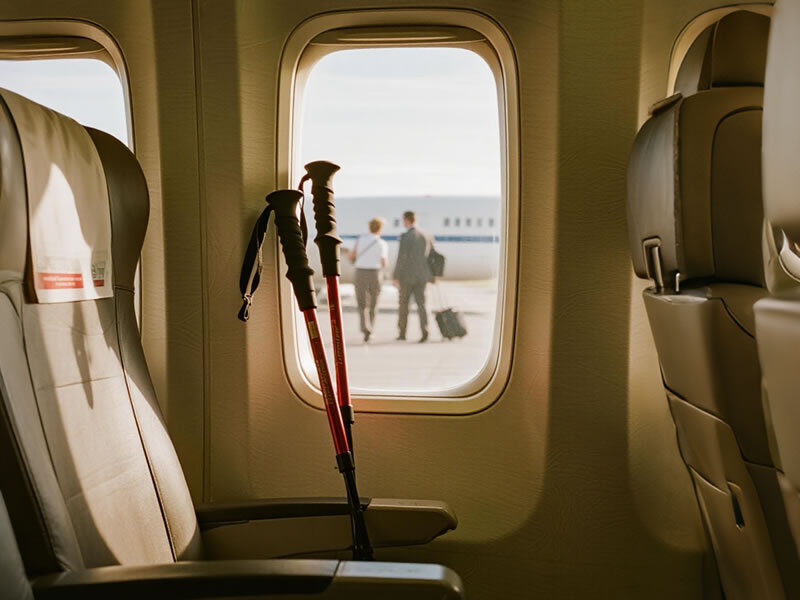Are trekking poles allowed on airplanes?
Planning to fly to your next hiking adventure but unsure if your trusty trekking poles can join you? The answer is yes, trekking poles are generally allowed on airplanes, but crucial rules and significant risks dictate how you transport them. Navigating airline and security regulations correctly is essential to avoid confiscation or damage. Here’s everything you need to know:

The Golden Rule: Collapsibility is Key
- Fully Collapsible Poles: These might be permitted in carry-on luggage only if they collapse short enough to fit within your airline’s carry-on size restrictions (typically under 22-24 inches / 56-61 cm when fully shortened). However, this is highly risky.
- Non-Collapsible or Fixed-Length Poles: These must always be packed in checked luggage. They cannot go through security as carry-on.
The Carry-On Conundrum: Why Checking is Strongly Recommended
While TSA (US) and similar security agencies (like EASA in Europe) technically allow collapsible poles in carry-on if they fit size rules, real-world enforcement is inconsistent and often strict:
- Security Officer Discretion is Supreme: TSA explicitly states trekking poles are "permitted as carry-on ONLY if they can be collapsed small enough to fit." Even then, individual officers have broad authority. If an agent deems any pole a potential weapon (which they easily can), it will be confiscated at the checkpoint. There is no guaranteed appeal.
- Airline Policies Vary: Even if TSA allows them through security, your specific airline might have stricter carry-on rules prohibiting them outright. Always check your airline's "prohibited items" list.
- International Travel Adds Complexity: Rules differ significantly by country. Some nations (and airlines based there) explicitly ban trekking poles in the cabin regardless of size. Research your destination's regulations meticulously.
- Hassle Factor: Be prepared for extra scrutiny, potential bag searches, and delays. Is the stress worth it?
Checked Luggage: The Safe & Reliable Choice
Packing your poles in your checked baggage is overwhelmingly the most secure and recommended method:
- Protect Your Poles:Use Protective Tips: Cover sharp carbide tips with rubber tip protectors (included with most poles) or DIY solutions (corks, foam, thick tape) to prevent punctures.Secure the Shafts: Collapse them fully and use Velcro straps or rubber bands to keep sections together.Padding is Paramount: Place poles inside your suitcase, ideally along the edge or between layers of clothing/sleeping bag for cushioning. Avoid strapping them loosely to the outside of your pack – baggage handlers are not gentle. For maximum protection, invest in a dedicated trekking pole travel case or sturdy cardboard tube.
- Prevent Snags: Ensure straps are tucked in or secured. Loose straps can get caught in conveyor belts.
Essential Pre-Flight Checklist
- Verify Airline Policy: Visit your airline’s website. Search "prohibited items" or "sporting equipment."
- Check Security Regulations: Review TSA.gov (US) or equivalent agency site for your departure and arrival countries. Search "trekking poles" or "hiking poles".
- International Flights: Research destination country rules and rules for any layover countries. When in doubt, CHECK THEM.
- Collapse & Protect: Ensure poles collapse fully. Apply tip protectors and secure straps.
- Choose Checked Luggage: Unless you have ultra-short, collapsible poles and accept the high risk of loss, checking them is prudent.
- Consider Poles at Destination: For popular hiking destinations, renting poles locally is often inexpensive and eliminates travel hassle entirely.
Key Takeaways for Stress-Free Flying
- Technically Possible ≠ Advisable: Just because collapsible poles might be allowed as carry-on doesn't mean they will be allowed. Assumption of risk is high.
- Checked Baggage is King: This is the safest, most reliable, and least stressful option for transporting trekking poles by air. Protect them well inside your main checked suitcase.
- Research is Non-Negotiable: Airline and security rules change. Never assume policies are static. Verify directly with official sources close to your travel date.
- Protect Tips and Shafts: Prevent damage to your gear and other luggage.
- International = Extra Caution: Rules abroad are often stricter. Assume poles must be checked.
Conclusion: Fly Smart, Hike Happy
While you can fly with trekking poles, doing so successfully hinges on prioritizing checked luggage, meticulous packing, and thorough research. The convenience of carrying poles onboard is vastly outweighed by the very real risk of confiscation at security. By packing them securely inside your checked bag—protected with tip covers and padding—you guarantee your essential hiking tools arrive ready for the trail. Always double-check the latest airline and security regulations before you fly, and enjoy your adventure with peace of mind!






